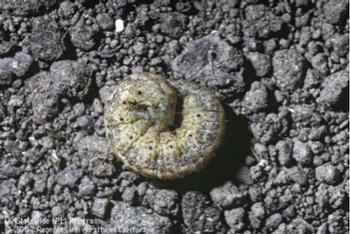Cutworm
-
AboutCutworms are dull brown caterpillars one to two inches long when fully grown. They curl into a C-shape when disturbed. Some clip off seedling stems, while others chew or bore holes.
 Variegated cutworm, Peridroma saucia, larva. Photo by Jack Kelly Clark
Variegated cutworm, Peridroma saucia, larva. Photo by Jack Kelly Clark -
CategoryInsect
-
Signs/Symptoms
Cutworms feed on blossoms and leaves of many ornamental plants and attack most edible garden crops. They clip off seedling stems near or just below the soil level. A few species chew holes into leaves or bore into heads of lettuce or cole crops. Holes may be chewed in young fruit or vegetables, and fruiting stems wilt and fall. New shoots may be eaten partway through.
-
Where
Normally found on or just below the soil surface or on lower parts of plants. Commonly active at night. They are smooth-skinned and have various markings that blend well with the soil.
-
When
Cutworms are pests mainly in the spring.
-
Prevent
Destroy crop residues; keep garden weed-free in winter.
In vegetable gardens, protect seedlings with cardboard collars, screen, or protective cloth. Always plant a greater stand than desired to allow for some losses by seedling pests. Some damage can be avoided by planting hardy transplants.
Provide proper fertilization and water, protect roots and trunks from damage, and prune trees properly when needed.
-
Manage
Hand-picking at night with a flashlight is very effective. Clip and dispose of infested foliage and blossoms. Climbing cutworms can be kept out of perennial crops such as berries with sticky collars. Larger garden plants may be protected with Bacillus thuringiensis (Bt). Pesticides are ineffective and not recommended.
-
More Information

